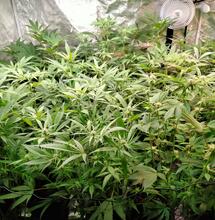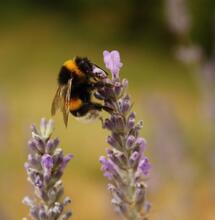9 Top Tips on Growing The Best Quality Cannabis Buds Outdoors
_0.jpg)
Growing Cannabis outdoors can be hard work, but well worth it when it comes to harvesting those monster plants, and filling your jars up for the next year. Unfortunately, things can easily go wrong during the flowering stages, causing the buds to become airy, stressed and lacking in essence. In this article, we provide 9 top tips to consider producing the best quality outdoor Cannabis buds possible!
Top Tip #1 - Light Intensity
How much intense lighting your outdoor plants receive will make a massive difference in the amount of resin, terpenes and final weight. Some growers may lack the final few weeks that their plants need, causing buds to become small, light and airy in appearance.
Our top tip here is to provide as much sunlight as possible, and to keep the plants in a South facing location. This will ensure they get the final hours of sun before sun set, and this is also the ideal time to feed them.
Top Tip #2 - Support the plants
Cannabis plants, which are well-trained and supported prior to flowering, will always perform much better due to the plants being able to focus on producing top-heavy fat buds. As the buds and resin begin to form, side branches can become weighed down and begin to topple or lean onto other plants.
This can often lead to many problems and plant disease spreading, so our top tip here is to use bamboo canes and to insert them around the edges of a circular pot like the numbers of a clock. Do not insert into the center parts of the pots where the main roots are, and tie the branch and cane together firmly into the side.
Top Tip #3 - Prune the lower foliage
Pruning is one of the most practical ways to eliminate any bushy growth that may attract insects or pathogens. Pruning will also dramatically improve air flow around the center and top of the plants and is a great opportunity to take large sized cuttings.
Our top tip here is to prune away 75% of the lower foliage, leaving behind only the main crown shoots. As the plants flower, the top canopy will finish around 75-100 cm tall, depending on the strain and climate.
Top Tip #4 - Avoid foliar feeding buds
Spraying your plants with nutrients, or even using water in an attempt to cool them down, is not recommended, especially once the buds are forming beyond week 5. Spraying the buds with any type of liquid will cause moisture to build up and for powdery mildew or mold to start setting in.
Our top tip here is that in the same way that heavy rainfall can cause a chain of negative events, spraying your plants with a hose pipe or spray bottle is not a good idea. Only feed through the roots and if the plants are too hot, then provide shade for them.
Top Tip #5 - Over watering your plants
One of the most common mistakes a beginner grower will make is to over water their plants during the final 4 weeks of flower production. Many times, they notice signs of nutrient deficiencies or toxicities, and before they know it, are flushing their plants with large volumes of plain water or nutrient solution.
Our top tip here is to continue feeding the same amount of water each time, and allow the plants to do the work. It is essentially the growing medium does not become oversaturated and the roots have plenty of oxygen.
Top Tip #6 - Letting buds touch the floor or walls
A common problem which greenhouse growers can face is allowing side branches to droop low enough to touch glass walls or other plants. In extreme cases, side branches can touch the floor, which can quickly lead to problems.
Buds that come into contact with a wet and cold glass window will soon become contaminated with mold that can cause a great amount of damage if not treated. Our top tip here is to be vigilant and do daily checks to make sure the side branches are not drooping on the floor, leaning on glass windows or other plants.
Top Tip #7 - A lack of fresh air
As your buds start to get bigger and more dense, it is essential that there is a fresh amount of air blowing around the buds. Aerobic bacteria and pathogens will quickly attack vulnerable Cannabis plants, who thrive in conditions with very little air, high humidity and temperatures.
Spider mites and white flies will also infect your garden and lay eggs in a short time when there is poor air flow, so our top tip here is to open your plants up using plant training to increase the amount of direct light and air flow.
Top Tip #8 - Ignoring molding buds
It is not always easy to spot the first signs of mold attacking the buds, and even more so when they are enormous plants that are as tall as 8–12 feet. One of the most difficult parts of growing outdoors over the seasons is the threat of caterpillars, spider mites, white fly, thrips, powdery mildew and the worst case scenario, molding buds.
You will be able to identify mold if the bud has become like cotton candy or a spider web texture and yellowing color. Our top tip here is to cut away molding buds with a sterile and clean pair of scissors, and to keep removing any parts which aggressively spread.
Top Tip #9 - The harvest window
The final and most important top tip is to pick the perfect harvest window. Knowing the exact day to chop the plants down should be based on the trichome maturity, terpene production, amount of resin, how swollen the calyx have become, the number of brown hairs and overall appearance.
Our top tip here is to check the trichomes with a microscope lens and to see what the resin glands are telling you. When the majority of the trichomes are silver and milky colored, this can be the optimal moment to harvest your outdoor crop.
Conclusion
Growing outdoors can make or break a grower and can be the difference between having your personal head stash sorted for the next 6–9 months, or a waste of time and money. We hope this article provides you with plenty to think about over the next few months as your outdoor crop gets bigger every day. Good luck in producing the best buds possible in 2023!.



